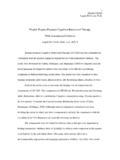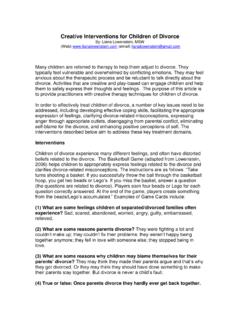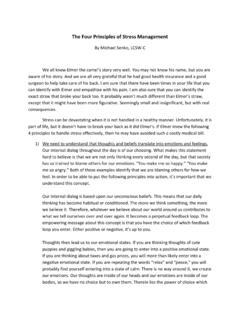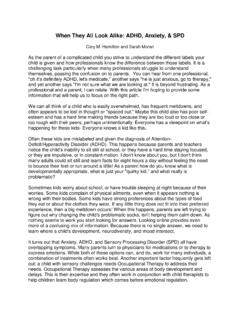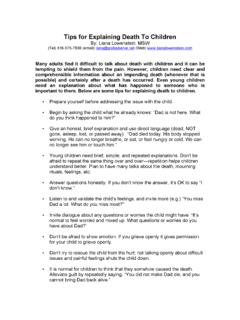Transcription of Managing Vicarious Trauma and Compassion Fatigue
1 Managing Vicarious Trauma and Compassion Fatigue Heather M. Helm, PhD, LPC, RPT-S I used to believe the world was basically fair and that people were basically good. Now I think fate is fickle and I don t trust anyone. Saakvitne & Pearlman, Transforming the Pain The practice of counseling is an intense, personal relationship, and it is often emotional. Successful counseling demands that mental health professionals be empathically engaged in the pain of the person they are helping. Despite mental health professionals being trained to maintain a certain degree of professional distance, this typically refers to the personal and professional boundaries necessary for ethical practice.
2 Maintaining professional distance does not insulate the practitioner from the effects of intense emotional content. As a result, practitioners can be affected by exposure to the powerful and at times Trauma -based experiences of their clients, which at times result in Vicarious Trauma or Compassion Fatigue . While exposure to traumatic material can affect mental health practitioners across therapeutic modalities and theories, play therapists especially have greater exposure to traumatic material. Rather than listening to recollections of traumatic events as in traditional talk therapy, play therapists witness traumatic experiences unfold through the play of the child.
3 Witnessing traumatic events through play, or experiencing the traumatic event through the eyes of the child, may increase the susceptibility of the play therapists to experiencing Vicarious Trauma or Compassion Fatigue . Defining Vicarious Trauma and Compassion Fatigue Vicarious Trauma and Compassion Fatigue are unique phenomena, though they are terms that are often used interchangeably. Vicarious Trauma is defined as a transformation of the helper s inner experience, resulting from empathic engagement with clients Trauma material (Saakvitne & Pearlman, 1996, p.)
4 40). When therapists experience Vicarious traumas, their inner experiences and their views of the world are affected. Though one client story can elicit traumatic responses in a therapist, repeated exposure to traumatic material across time and across clients can lead to Vicarious traumatization. Compassion Fatigue is defined by the specific behaviors and emotions exhibited by therapists in response to a client s traumatic content. Specifically, Compassion Fatigue consists of the manifestation of post-traumatic stress disorder (PTSD) symptoms in the therapist. The primary difference between PTSD and Compassion Fatigue is the experience of the traumatic event.
5 The therapist experiences the event second hand (listening to or witnessing the experience, as in play therapy) rather than directly. Unlike Vicarious Trauma , Compassion Fatigue can occur from work with a single client (Figley, 1995). While a complete discussion of both Compassion Fatigue and Vicarious Trauma are outside the focus of this article, it is important to understand the distinction between the two. A more detailed description of Vicarious Trauma is the focus of the remainder of this article. Constructivist Self-Development Theory The concept of Vicarious traumatization is based on the constructivist self-development theory (CSDT) (Saakvitne & Pearlman, 1996).
6 Understanding the concept of CSDT can assist the practitioner in identifying the experience and manifestation of Vicarious Trauma . CSDT describes how exposure to traumatic material affects the self; in this case, the self of the therapist. CSDT asserts that individuals construct their realities based on their perceptions and schemas (Trippany, White Kress, & Wilcoxon, 2004). In this context, therapists cope with traumatic material based on their current circumstances and their early experiences (Saakvitne & Pearlman, 1996); specifically, their interpersonal, intrapsychic, familial, cultural, and social experiences.
7 Through the CSDT lens, symptoms resulting from traumatic events are seen as adaptations to the events. When individuals are exposed to events that do not fit within their current perceptions of reality, irrational or distorted beliefs protect the individuals and their meaning system from the harm caused by the Trauma . From the perspective of this theory, Vicarious traumatic responses are adaptive responses to hearing clients describe their traumatic experiences. For example, a therapist who works with rape victims may begin to see the world as an unsafe place. By maintaining this assumption, the therapist can engage in behaviors and feelings consistent with an unsafe world in an attempt to protect herself from harm.
8 CDST also asserts that the changes in the therapist s belief system and cognitive schemas, while adaptive, are both pervasive and cumulative (Trippany et al., 2004). Changes are pervasive in that they have the potential to touch nearly every aspect of a therapist s life, and cumulative in that each encounter with a traumatized client reinforces beliefs and schemas. According to this theory, there are five components of self, each of which can be potentially affected by exposure to traumatic material. The five components are frame of reference; self-capacities; ego resources; psychological needs and cognitive schemas; and memory and perception (Saakvitne & Pearlman, 1996).
9 An individual s frame of reference includes his/her sense of identity and his/her views of self, the world, and relationships. Self-capacities refer to an individual s ability to manage strong emotions and feel worthy of loving and being loved. A person possessing ego resources has the capacity for empathy and self-awareness. The person with ego resources has good interpersonal skills and maintains good personal boundaries. Psychological needs and cognitive schemas are an individual s personal needs for safety, esteem, trust, control, and intimacy. The cognitive schemas around these needs are reflected in an individual s belief about self and others.
10 Finally, memory and perception are often affected by a traumatic event. Memories can become fragmented and disjointed, or recalled without emotion. It is within these components of CDST that Vicarious traumatic reactions occur. Symptoms of Vicarious Trauma While the symptoms of Vicarious Trauma can differ according to the individual s life experiences and perceptions about the traumatic event, there are several common signs and symptoms of Vicarious Trauma that often occur in the mental health practitioner. The dimensions of symptoms are across emotion, cognitive, physical, and behavioral realms (Morrissette, 2004; Saakvitne & Pearlman, 1996).
